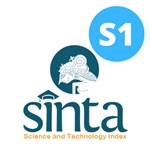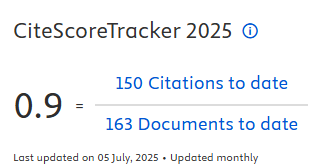A Model of Factors Affecting the Use of Personal Protective Equipment Using a Path Analysis among PLTU Contractor Workers in East Java
Downloads
Introduction: Based on the survey data in one of the PLTUs in East Java from January-November 2019, there were 9.134 findings of non-compliance with PPE. In addition, based on the audit data from October to November 2019, there were 125 findings of non-compliance with the use of PPE. The factors causing this non-compliance could be seen from the characteristics of the workers or could be based on the Health Belief Model (HBM) approach through 6 constructs. Based on these data, this article aimsto analyze a model of factors that have a direct and indirect effect on the use of PPE on PLTU contractor workers in East Java. The researchers used the Health Belief Model approach because the use of PPE for workers is an effort related to healthy behavior in the workplace. Methods: This research was a quantitative research. The total sample was 100 workers from a population of 400 contractors workers, based on the Slovin methodand as a fulfillment of the path analysis requirement. The analyses of direct and indirect effects between variables used a path analysis method. Results: The results of data processing showa direct effect of perceived benefits (t=4,837), cues to action (t=5,990), perceived severity (t=2,131), knowledge (t=3,183), and perceived susceptibility (t=2,212) on the use of PPE, while education iis known to have an indirect effect on the use of PPE through knowledge (t=2,222). Conclusion: Perceived benefits, cues to action, perceived severity, knowledge, and perceived susceptibility have a direct effect on the use of PPE. However, education has an indirect effect on the use of PPE through knowledge.
Keywords: health belief model, occupational diseases, path analysis, personal protective equipmentAfini, P. N., Koesyanto, H. and Budiono, I. (2012) ‘Faktor Penyebab Kecelakaan Kerja di Unit Instalasi Pabrik Gula', Unnes Journal of Public Health., 1(1), pp. 45–50.
Arifin, A. B. and Susanto, A. (2013) ‘Faktor-Faktor yang Berhubungan dengan Kepatuhan Pekerja Dalam Pemakaian Alat Pelindung Diri (APD) di Bagian Coal Yard PT X Unit 3 & 4 Kabupaten Jepara Tahun 2012', Jurnal Kesehatan Masyarakat, 2(1), pp. 1–6.
Chotimah, C. C., Haryadi and Roestijawati, N. (2019) ‘Pengaruh Pengetahuan, Motivasi dan Persepsi Risiko terhadap Perilaku Penggunaan Alat Pelindung Diri Dasar yang Dimoderasi Faktor Pengawasan pada Civitas HospitaliaRSGMP Unsoed 1,2,3', Jurnal Ekonomi, Bisnis, dan Akuntansi, 21(3), pp. 1–11.
Dewantara, B. P., Murti, B. and Widyaningsih, V. (2019) ‘Application of Health Belief Model and Social Cognitive Theory on the Use of Personal Protective Equipment among Workers at the Plywood Plant : Path Analysis Evidence from Lumajang , East Java', Journal of Health Promotion and Behavior, 4(4), pp. 306–318.
Dewi, R. D., Rahardjo, S. S. and Murti, B. (2019) ‘Path Analysis on the Factors Affecting the Use of Personal Protection Equipment among Airport Construction Workers in Yogyakarta', Journal of Health Promotion and Behavior, 4(1), pp. 12–21.
Fanani, S. and Dewi, T. K. (2014) ‘Health Belief Model pada Pasien Pengobatan Alternatif Supranatural dengan Bantuan Dukun', Jurnal Psikologi Klinis dan Kesehatan Mental, 3(4), pp. 54–59.
Gunawan, I. and Mudayana, A. A. (2016) ‘Hubungan Antara Pengetahuan, Sikap Dan Motivasi Dengan Perilaku Penggunaan Alat Pelindung Diri Pada Pekerja Bagian Produksi PT.Katingan Indah Utama, Kabupaten Kotawaringin Timur, Provinsi Kalimantan Tengah', Unnes Journal of Public Health, 5(4), pp. 336–347.
Harlan, A. N. (2017) ‘Faktor yang Berhubungan dengan Perilaku Penggunaan APD pada Petugas Laboratorium Rumah Sakit PHC Surabaya', The Indonesan Journal of Occupational Safety and Health, 6(3), pp. 278–287.
Hidayah, N., Tunggul P, E. and Budi R, B. (2015) ‘Analisis Faktor yang Berhubungan dengan Kepatuhan Memakai Alat Pelindung Telinga pada Tenaga Kerja Bagian Produksi di PT. Total Dwi Daya Semarang Tahun 2014', Unnes Journal of Public Health, 4(1), pp. 1–7.
Jatmiko, F., Setiyawan, H. and Atmojo, T. B. (2017) ‘Relationship Between Level Knowledge and Supervision To the Behavior of Apd Application in Construction Workers Pt Wika Beton Boyolali', Journal of Industrial Hygiene and Occupational Health, 2(1), p. 44.
Kalasuat, J. et al. (2019) ‘Analysis of use of Protective Equipment (PPE) in Employees PT Conch Cement Manokwari District West Papua', Galore International Journal of Health Sciences and Research, 4(1), pp. 62–71.
Putri, K. D. S. (2017) ‘Analisis Faktor yang Berhubungan dengan Kepatuhan Menggunakan Alat Pelindung Diri', The Indonesian Journal of Occupational Safety and Health, 6(3), pp. 311–320.
Rezaei, R., Seidi, M. and Karbasioun, M. (2019) ‘Pesticide Exposure Reduction: Extending the Theory of Planned Behavior to Understand Iranian Farmers' Intention to Apply Personal Protective Equipment', Safety Science, 120(December), pp. 527–537.
Sakinah, Z. V. (2017) ‘Aplikasi Health Belief Model dalam Menganalisis Perilaku Penggunaan Kacamata Pelindung', Jurnal Promkes, 5(1), pp. 115–128.
Sim, S. W., Moey, K. S. P. and Tan, N. C. (2014) ‘The use of Facemasks to Prevent Respiratory Infection: A Literature Review in the Context of the Health Belief Model', Singapore Medical Journal, 55(3), pp. 160–167.
Suma'mur (2013) Higiene Perusahaan Dan Kesehatan Kerja (Hiperkes). Jakarta: Sagung Seto.
Wright, T. et al. (2019) ‘Issue of Compliance with use of Personal Protective Equipment among Wastewater Workers Across the Southeast Region of the United States', International Journal of Environmental Research and Public Health, 16(11), pp. 1–18.

In order to be accepted and published by The Indonesian Journal of Occupational Safety and Health, Author(s) who submit an article should complete all the review process. The copyright of received articles assigned to the The Indonesian Journal of Occupational Safety and Health and Department of Safety and Health, Universitas Airlangga as publishers of the journal. The intended copyright includes the rights to publish articles in various forms (including reprints).
The Editorial Team of The Indonesian Journal Of Occupational Safety and Health and Department of Safety and Health strive to ensure that no errors occur in the articles that have been published, both data errors and statements in the article.
Users of this website will be licensed to use materials from this website following the Creative Commons Attribution-NonCommercial-ShareAlike 4.0 International License. No fees charged. Please use the materials accordingly.
------------------------------------------------------------------------------------------------------------------------------------------------------------------------------------------
Attribution ” You must give appropriate credit, provide a link to the license, and indicate if changes were made. You may do so in any reasonable manner, but not in any way that suggests the licensor endorses you or your use.
NonCommercial ” You may not use the material for commercial purposes.
ShareAlike ” If you remix, transform, or build upon the material, you must distribute your contributions under the same license as the original.







 How to Submit Articles in OJS
How to Submit Articles in OJS

























